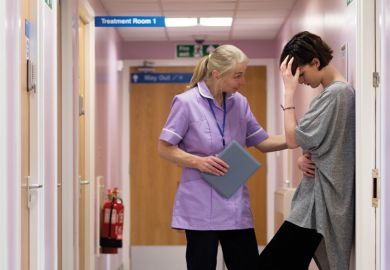Australia’s university representative body has proposed a shake-up of clinical placements for health students, as an already stretched medical workforce reels from coronavirus disruption.
In a change of tack from the customary demands for more higher education and research funding, Universities Australia (UA) has highlighted risks to the future health workforce in a submission recommending priorities for the 11 May federal budget.
The submission, which has been released publicly after being lodged with Treasury early this year, calls for a temporary “health service placement adjustment package” to tackle a Covid-induced backlog in clinical training.
The proposal sits alongside several relatively inexpensive or cost-free measures UA has requested from a budget that is not expected to yield much for the sector, after last year’s surprise allocation of an extra A$1 billion (£560 million) in research funding.
The submission says that while clinical placements always present “challenges”, Covid-19 has exacerbated them at the very time that the country needs more health workers to manage the vaccine roll-out, deliver “catch-up” treatments deferred during the pandemic, manage “post Covid-19 syndrome” and meet burgeoning needs for aged and disability care.
The submission says that the government should fund universities and community care providers to develop ways to “quickly expand placement capacity” outside hospitals.
UA also wants funding for a “scoping study” to explore ways for universities to share information about national security threats. This would help reduce the workload from a plethora of potentially “overlapping” regulatory regimes such as the Foreign Influence and Transparency Scheme, the new foreign relations act, the critical infrastructure bill and the proposed Commonwealth Integrity Commission.
The submission also requests the maintenance of visa flexibility measures introduced last year and a relaxation of work rules that limit international students’ freedom to accept stints of unpaid work experience. But it also includes big-ticket requests including another year’s “stabilisation funding” for university research, extended transition funding for the Job-ready Graduates (JRG) package and direct support for private research and development.
UA chief executive Catriona Jackson said that while last year’s A$1 billion windfall had saved “critical research capacity”, more was needed. “In a time of economic disruption, innovation and a productive skilled workforce become even more crucial to maintaining competitiveness and prosperity,” she said.
Sources expected little from the budget, with the government pursuing longer-term reforms. An expert group advising on the commercialisation of university research, a personal priority of education minister Alan Tudge, is not expected to report until later in the year.
Submissions on a new international education strategy fall due the day after the budget, and the government has already outlined spending measures to relieve the ailing sector – with private colleges the primary beneficiaries.
Analyst Martin Foo said that the budget was unlikely to include new teaching grants so soon after the JRG changes, and significant extra research funding was doubtful following last year’s windfall.
But Mr Foo, of credit ratings agency S&P Global, said that universities could attract new infrastructure funding through schemes such as the city deals and the Northern Australia Infrastructure Facility.
Register to continue
Why register?
- Registration is free and only takes a moment
- Once registered, you can read 3 articles a month
- Sign up for our newsletter
Subscribe
Or subscribe for unlimited access to:
- Unlimited access to news, views, insights & reviews
- Digital editions
- Digital access to THE’s university and college rankings analysis
Already registered or a current subscriber? Login








